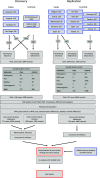Shared and Distinct Genomics of Chronic Thromboembolic Pulmonary Hypertension and Pulmonary Embolism
- PMID: 38470220
- PMCID: PMC11208965
- DOI: 10.1164/rccm.202307-1236OC
Shared and Distinct Genomics of Chronic Thromboembolic Pulmonary Hypertension and Pulmonary Embolism
Abstract
Rationale: Chronic thromboembolic pulmonary hypertension involves the formation and nonresolution of thrombus, dysregulated inflammation, angiogenesis, and the development of a small-vessel vasculopathy. Objectives: We aimed to establish the genetic basis of chronic thromboembolic pulmonary hypertension to gain insight into its pathophysiological contributors. Methods: We conducted a genome-wide association study on 1,907 European cases and 10,363 European control subjects. We coanalyzed our results with existing results from genome-wide association studies on deep vein thrombosis, pulmonary embolism, and idiopathic pulmonary arterial hypertension. Measurements and Main Results: Our primary association study revealed genetic associations at the ABO, FGG, F11, MYH7B, and HLA-DRA loci. Through our coanalysis, we demonstrate further associations with chronic thromboembolic pulmonary hypertension at the F2, TSPAN15, SLC44A2, and F5 loci but find no statistically significant associations shared with idiopathic pulmonary arterial hypertension. Conclusions: Chronic thromboembolic pulmonary hypertension is a partially heritable polygenic disease, with related though distinct genetic associations with pulmonary embolism and deep vein thrombosis.
Keywords: genome-wide association study; pulmonary arterial hypertension; venous thromboembolism.
Figures




Comment in
-
Genetically Identifying the "Thromboembolic" in Chronic Thromboembolic Pulmonary Hypertension.Am J Respir Crit Care Med. 2024 Jun 15;209(12):1425-1426. doi: 10.1164/rccm.202402-0471ED. Am J Respir Crit Care Med. 2024. PMID: 38537124 Free PMC article. No abstract available.
References
-
- Kim NH, Delcroix M, Jenkins DP, Channick R, Dartevelle P, Jansa P, et al. Chronic thromboembolic pulmonary hypertension. J Am Coll Cardiol . 2013;62(25 Suppl):D92–D99. - PubMed
-
- Ende-Verhaar YM, Cannegieter SC, Vonk Noordegraaf A, Delcroix M, Pruszczyk P, Mairuhu AT, et al. Incidence of chronic thromboembolic pulmonary hypertension after acute pulmonary embolism: a contemporary view of the published literature. Eur Respir J . 2017;49:1601792. - PubMed
-
- Pepke-Zaba J, Delcroix M, Lang I, Mayer E, Jansa P, Ambroz D, et al. Chronic thromboembolic pulmonary hypertension (CTEPH): results from an international prospective registry. Circulation . 2011;124:1973–1981. - PubMed
Publication types
MeSH terms
Grants and funding
LinkOut - more resources
Full Text Sources
Medical
Research Materials
Miscellaneous

